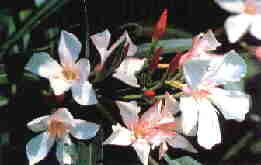
Known As: Dogbane, Oleander, Rose Bay, Rose Laurel
Latin Name: Nerium Oleander
Description: Has narrow, lane-shaped, leathery dark, dull
green leaves growing opposite each other. Leaves are 8-10 inches
long although shorter plants will have smaller leaves. Flowers are
clustered on terminal branches and are 1-3 inches in diameter. Sap
is so poisonous it is used in rat poison and as little as one leaf can
contain a lethal dose. Mature Oleander hedges may be as much as 20
feet high and the cane-like stems of youthful plants become very dense
as the bush matures. Flowers can be single or double and range in color
from red to pink, salmon, soft light yellow and white. These
should never be placed where animals can have contact with them.
Poisonous parts: All parts (extremely poisonous). Water
used for cut plants. Even small amounts can kill. Most
animals are poisoned by consuming leaves, fresh or dried. Oleander
contains the glycoside toxins oleandrin, oleandroside, and nerioside, which
are very similar to the toxins in foxglove (Digitalis).
Symptoms: Vomiting, bloody diarrhea, abdominal pain, abnormal
heartbeat, coma, death. Can be fatal.
Clinical signs may develop rapidly, and the animal may be found dead with
no prior warning. Irregularities in the heart rate and rhythm will occur:
the heart may speed up or slow down, and beat erratically. As the toxicosis
progresses, the extremities may become cold and the mucous membranes pale.
Trembling and collapse can occur, followed by coma and death within a few
hours.
Treatment: Contact a veterinarian immediately.
The toxin acts quickly, and is lethal
in small amounts. Emergency measures may be used to empty
the gastrointestinal tract of remaining plant matter, and medications
may be administered to control the effects that the toxin has on the heart.
Despite emergency care, the animal may still die, but the sooner
treatment is begun, the better the prognosis for survival.
